
art + people = x
January 9 – March 13, 2009
Helen Christou Gallery
The works and text featured here are part of a new project by the U of L Art Gallery. A range of people have been invited to select an art work from the university’s impressive art collection and tell a story about what connects them to this particular object. The selections were then featured in an exhibition in the Helen Christou Gallery and then archived with other, regularly up-dated further viewpoints on works in the art collection in the art + people = x section of our website.
Bruce McKay + Jeff Thomas =
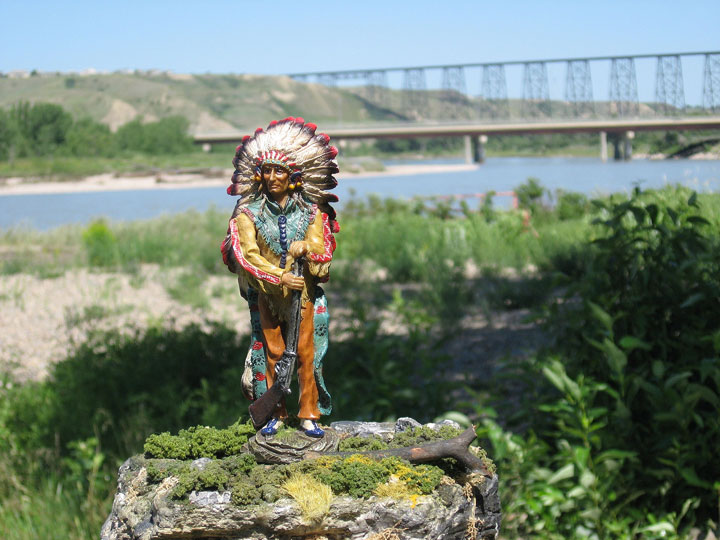 I’ve selected “The Delegate Visits Indian Battle Park” by Jeff Thomas. I connect with this work as a Lethbridgian, a walker in Indian Battle Park, a driver over the bridge, and a resident of the Westside. The context is very familiar. I am so accustomed to it that I barely give it any thought. But Thomas’ image caught me and made me stop and consider.
I’ve selected “The Delegate Visits Indian Battle Park” by Jeff Thomas. I connect with this work as a Lethbridgian, a walker in Indian Battle Park, a driver over the bridge, and a resident of the Westside. The context is very familiar. I am so accustomed to it that I barely give it any thought. But Thomas’ image caught me and made me stop and consider.
The colours are brighter and more intense than my eye naturally sees. The vibrancy is almost kitschy. The figure of the Delegate is almost kitschy too, like a cigar store figure. But there he is, in all his detailed and bright uprightness, set in Indian Battle Park, a manufactured figure in a manufactured scene in a manufactured place. The Park itself is a construction, a tamed and controlled stretch in the tamed river valley controlled by the dam upstream. He stands on a small built place matched to his size. Behind in the blurry background are the built bridges and houses of modern Lethbridge. This is not a ‘natural’ scene at all. How much natural is there really in this valley?
The Delegate also reminds me of a past when Blackfoot people lived and travelled along the river valley. He is an ironic visitor to me, a kitschy plastic idealized representative of a pre-European past, situated to remind us that our knowledge of the real past is now only preserved in place names like Indian Battle Park and in little plastic Indian figures. Although I live here now and this is my home, there were many other people who were here long before me. I know so little about them.
I wonder too about the Delegate and his relationship to Thomas. The artist is from the Onandaga First Nation of the Six Nations Confederacy in central Canada. Yet this Delegate is set in Blackfoot territory, a foreign country to Thomas. Is the artist intending to speak on behalf of Blackfoot people by sending his visitor to Indian Battle Park, near where the Blackfoot fought with the Cree? Is the Delegate somehow standing in judgment of that past event? Or is the Delegate set there for the modern residents like me as a representative of all First Nations peoples and standing in judgment of my limited knowledge and understanding of the time and people who were here before me? I still ponder these questions thanks to Thomas and “The Delegate Visits Indian Battle Park.”
JEFF THOMAS
Canadian, First Nations, Onondaga,
The Delegate Visits Indian Battle Park 2008
Giclee print, 2/15
From the University of Lethbridge Art Collection; gift of the artist, 2008
Lana Ing Gabor + Holly King =
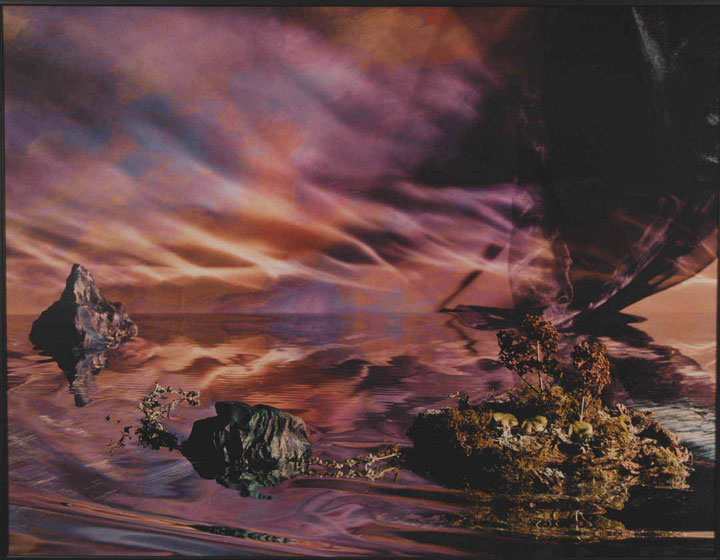 The constructed landscapes of Holly King evoke a dreamlike familiarity. As an artist who is also interested in fictional realities and recreated scenes I appreciate the fictional wilderness and “moodscapes” that King portrays in her contemporary landscapes. Her landscape-miniatures are built from materials such as tissue paper, plastic, wood, foliage, and clay, which she manipulates through lighting and compositional techniques to depict lush, colourful and often stormy environments. I was compelled to select this work because King’s use of non-natural materials to create familiar yet foreign places captures the illusion and imagination that are inherent in the photographic process.
The constructed landscapes of Holly King evoke a dreamlike familiarity. As an artist who is also interested in fictional realities and recreated scenes I appreciate the fictional wilderness and “moodscapes” that King portrays in her contemporary landscapes. Her landscape-miniatures are built from materials such as tissue paper, plastic, wood, foliage, and clay, which she manipulates through lighting and compositional techniques to depict lush, colourful and often stormy environments. I was compelled to select this work because King’s use of non-natural materials to create familiar yet foreign places captures the illusion and imagination that are inherent in the photographic process.
Lana Ing Gabor
HOLLY KING
Appear 2001
Colour photograph, 2/5
From the University of Lethbridge Art Collection; gift of the artist, 2006
The Cedar Tavern Singers (Mary-Anne McTrowe/Daniel Wong) =
Last summer, I happened to be in Edmonton when the Cedar Tavern Singers AKA Les Phonoréalistes were performing there. I have seen them many times in Lethbridge, but as so often happens, one has to travel to fully appreciate what one has at home. As I watched them perform my two favourites of their songs, one about the Sobey Art Awards and one about the differences between East Coast and West Coast artists, I had an epiphany. The University of Lethbridge Art Collection is legendary, so shouldn’t the collection have its own song?
I asked Mary-Anne and Dan if they were interested in producing a song for the art + people = x series. They readily agreed and quickly came up with an even better idea: not just one song, but a 4 song EP titled Mandate for Research. They also proposed making a music video and wanted to shoot it in the art vault. With the guarantee that no art would be harmed in the making of the video, the production went ahead. The legend of the University of Lethbridge Art Gallery continues to grow with the acquisition of a copy of the songs and related material for the collection.
Josephine Mills,
Director/Curator
THE CEDAR TAVERN SINGERS AKA LES PHONORÉALISTES
Mandate for Research 2008
4-Song EP, music video
From the University of Lethbridge Art Collection; commissioned by the UofL Art Gallery in 2008
+
GERALD FERGUSON
Detail of Maquette for One Million Pennies 1979
One copper penny from 1979
From the University of Lethbridge Art Collection; gift of the artist, 1987
Selected by the Cedar Tavern Singers: Mary-anne McTrowe and Daniel Wong
Allyson Clay + Eric Cameron and Dennis Oppenheim =
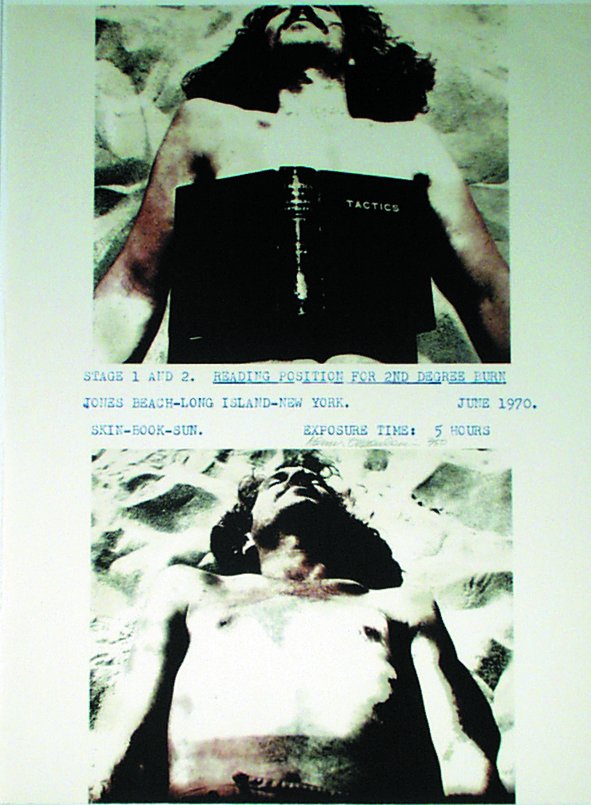
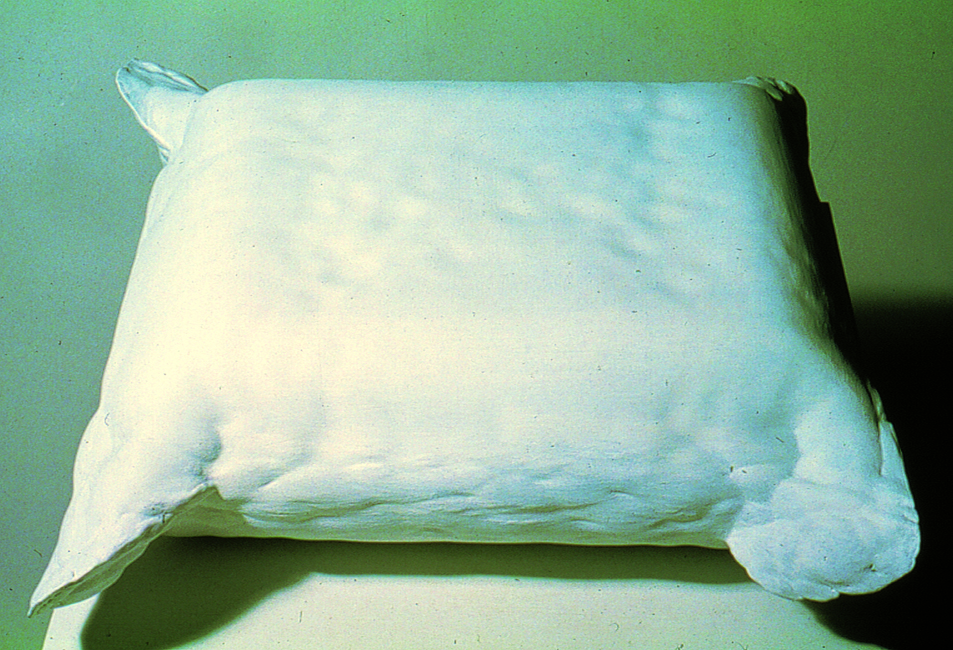 When I asked Allyson Clay to select a work or two from the collection, I had an agenda in mind. As a lover of books and a fan of artists who use books in their work, it was a safe assumption that Allyson would select something book-ish. It was a lovely surprise which two works she found most compelling as neither was one that I had thought of: Dennis Oppenheim’s “Reading Position for 2nd Degree Burn” and Eric Cameron’s “Telephone Directory”. The best part of her selection was that, like a good book, the works generated a great conversation between us.
When I asked Allyson Clay to select a work or two from the collection, I had an agenda in mind. As a lover of books and a fan of artists who use books in their work, it was a safe assumption that Allyson would select something book-ish. It was a lovely surprise which two works she found most compelling as neither was one that I had thought of: Dennis Oppenheim’s “Reading Position for 2nd Degree Burn” and Eric Cameron’s “Telephone Directory”. The best part of her selection was that, like a good book, the works generated a great conversation between us.
As is apparent in her recent art practice, Allyson is interested in “the secret life of books” and “the many uses that they have.” In Cameron’s ‘thick painting’ the book’s existence is secret indeed given that Cameron has covered it in layer upon layer of gesso, but the fact that it is actually a telephone book inside all that acrylic matters. For me, I see the work as another in the long list of connections between artists and their books. Allyson related to the work because it embodies “how books can be a taking off point for conceptual practice” and because she enjoys the play between “a book as an object and a book as a sign for ideas.”
Allyson selected Oppenheim’s work for the role the book has in “transforming the relationship between objects to each other, bodies to objects, and how this combines to transform ideas.” Talking about the work with Allyson opened up the question of what is the object here: the book? the sunburn? the artwork? or that the next time you are reading in the sun, will you think about getting the outline of a book burned on your skin? As we talked about the connection between books and the artist’s process, it became clear that books can function as muse, material and medium in the making of art.
Josephine Mills in conversation with Allyson Clay
Top:
DENNIS OPPENHEIM
Reading Position for 2nd Degree Burn 1970
Lithograph on paper, 2/50
From the University of Lethbridge Art Collection; gift of Garry N. Kennedy, 1987
Right:
ERIC CAMERON
Telephone Directory 1994
Acrylic gesso, telephone directory
From the University of Lethbridge Art Collection; gift of the artist, 1996
Linda Sawchyn + Bill Featherston =
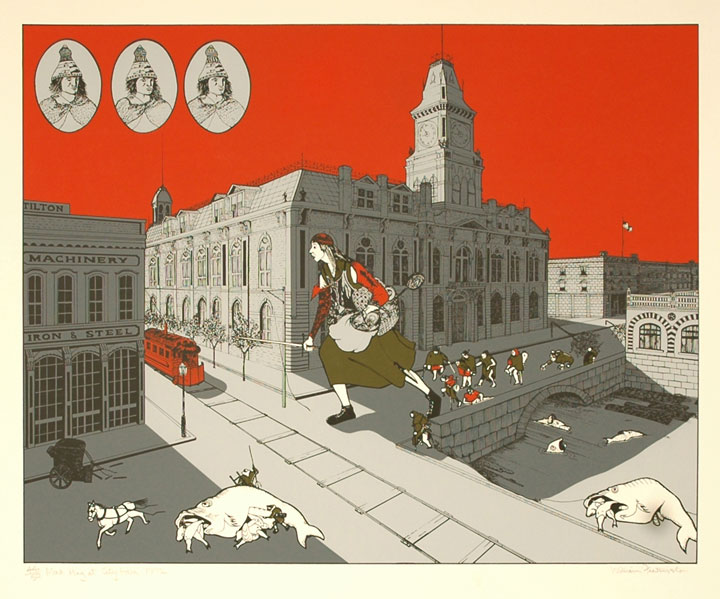 After the world wide collapse of the auto industry, all forms of banking institutions soon followed suit and so it was that 20th century capitalism collapsed. As the Mayans predicted, this all happened by 2012. Not surprisingly, life on earth did continue for awhile albeit it was a difficult transition for some. It truly was the end of the world as we have known it.
After the world wide collapse of the auto industry, all forms of banking institutions soon followed suit and so it was that 20th century capitalism collapsed. As the Mayans predicted, this all happened by 2012. Not surprisingly, life on earth did continue for awhile albeit it was a difficult transition for some. It truly was the end of the world as we have known it.
Yet, the human species and its will to survive is not easily extinguished. New forms (or rather old forms) of transportation were revitalized including the beloved streetcar and the horse and buggy. While the infrastructure of urban life was still in good shape fewer people lived in the cities anymore. Many moved to the country where they could either grow their food or at least be closer to those who did grow food.
Even Meg the recently immigrated Flemish giant found new meaning in life. After being laid off from Giants Are Us she started an Ashram by the river and quickly attracted a small group of faithful female followers. In less than a year they became particularly good at farming fish. Their specialty was a kind of genetically engineered nesting fish that they developed in which a small living fish grew inside a larger living fish which grew inside yet a larger living fish – up to 8 different sizes of fish!! They called it The Brueghel Feast Beast. If it was still possible to patent this life form (which it wasn’t) Meg would have made a fortune (which no longer had any meaning in a non monetary economy).
But of course everyone knew they were living on borrowed time. After all it was too late to stop, slow down or reverse global warming. Day by day the earth turned more and more into a living hell. The planet continued to warm, the sky grew increasingly red, the ice bergs melted and the earth’s fresh water temperature increased to the point when one day Meg and her Ashramians woke up to a river full of perfectly poached Brueghel Feast Beasts. Boy was Meg mad.
Linda Sawchyn
BILL FEATHERSTON
Mad Meg at City Hall 1972
Silkscreen on paper, 44/50
From the University of Lethbridge Art Collection; gift of William Varda, 1987
The Lesbian Rangers (Shawna Dempsey/Lorri Millan)+Margaret Shelton=
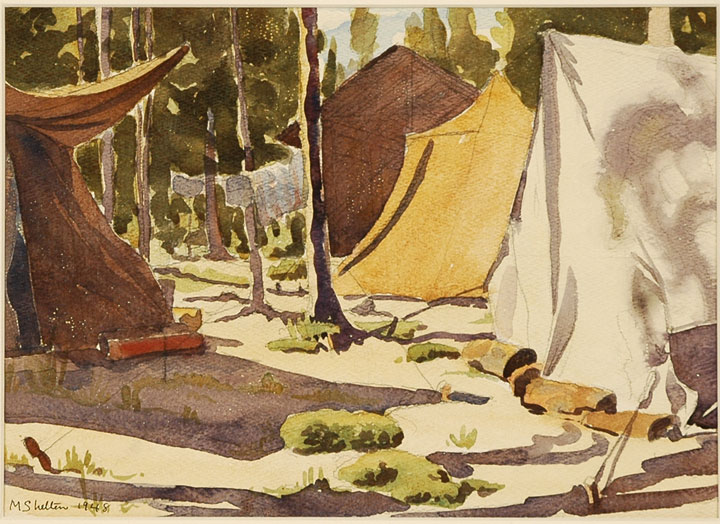
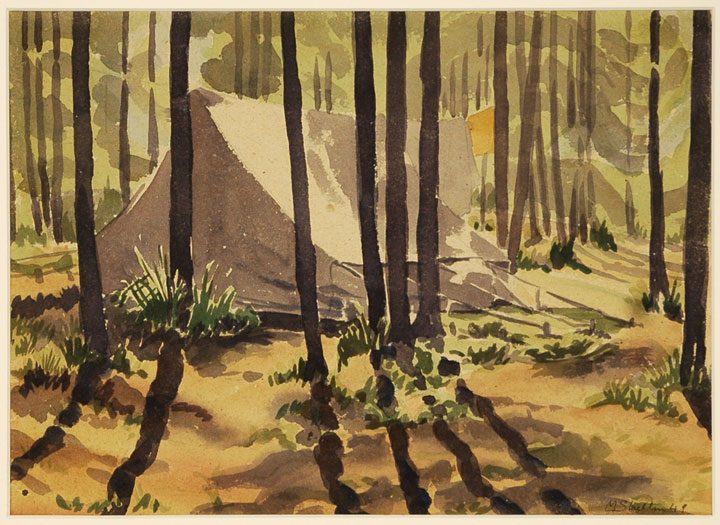 The life of Alberta artist Margaret Shelton is cloaked in mystery. However, we do know she was an avid outdoorswoman who painted in the field, relishing the arousing breezes and invigorating scents that come with activities en plein air. A substantial body of her work rests in the collection of the University of Lethbridge Art Gallery, including these two watercolours that speak so directly to the hearts of the Lesbian Rangers. We have awoken many a morning to soft dawn light angling through the trees, the sound of canvas snapping in the gentle breeze. In these moments of calm we relish the warm embrace of Mother Nature as we prepare ourselves for the lesbian rigours that await.
The life of Alberta artist Margaret Shelton is cloaked in mystery. However, we do know she was an avid outdoorswoman who painted in the field, relishing the arousing breezes and invigorating scents that come with activities en plein air. A substantial body of her work rests in the collection of the University of Lethbridge Art Gallery, including these two watercolours that speak so directly to the hearts of the Lesbian Rangers. We have awoken many a morning to soft dawn light angling through the trees, the sound of canvas snapping in the gentle breeze. In these moments of calm we relish the warm embrace of Mother Nature as we prepare ourselves for the lesbian rigours that await.
Margaret Shelton’s subtle renderings of nature place us squarely in its midst, a part of the landscape, neither overwhelmed nor separate, but of it. It is a gift the Lesbian Rangers can only aspire to.
The Lesbian Rangers
MARGARET SHELTON
Left: Crowded Camp 1948
Right: Morning in Camp 1949
Watercolour on paper
From the University of Lethbridge Art Collection; gift of the artist, 1982
Juliet Graham + A.Y. Jackson =
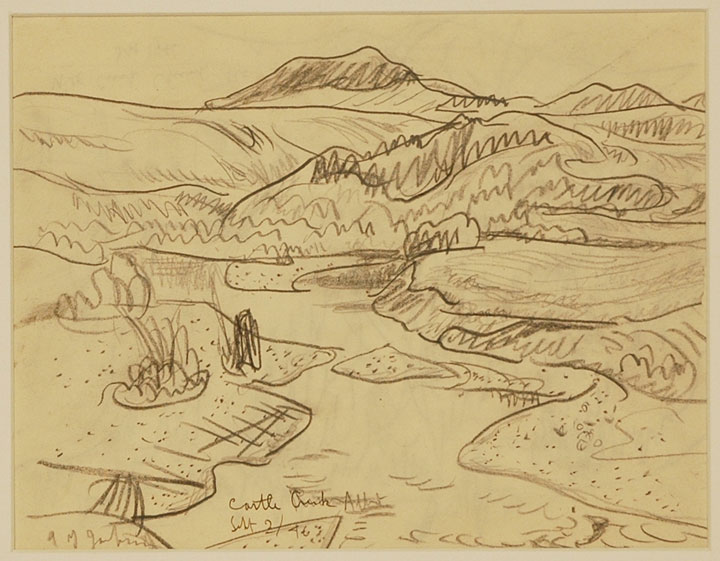
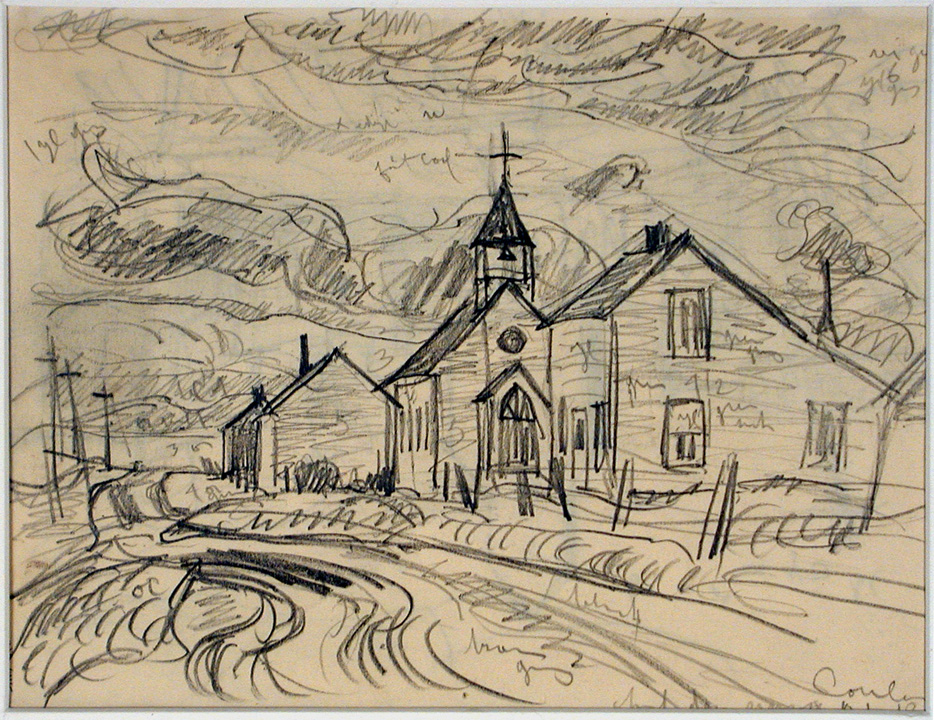 “I chose these drawings because I love them. I love that they were done so quickly and scribbly; the artist’s notes and little colour/number reminders blending together into the image. I also love that they are from another time: they are charming.”
“I chose these drawings because I love them. I love that they were done so quickly and scribbly; the artist’s notes and little colour/number reminders blending together into the image. I also love that they are from another time: they are charming.”
Juliet Graham
A.Y. JACKSON
Left: Castle River, Alberta, 1946
Right: Cowley, 1947
Graphite on paper
From the University of Lethbridge Art Collection; acquired in 1970
Courtesy of the Estate of the late Dr. Naomi Jackson Groves
Brian Black + Edward Steichen =
The photographs by Edward Steichen (1879-1973) in this exhibit all date from the 1930s. They were chosen to celebrate the featured decade of this year’s Historic Lethbridge Week, which will take place from May 2 to 9, 2009 and will showcase the art and culture of that period. In his portraits of celebrities of the 1930s, produced for such magazines as Vogue and Vanity Fair, Steichen captured the mystery and allure of America’s silver screen. The exhibit includes evocative images of such stars as Marlene Dietrich, Gary Cooper and Joan Crawford. The one photograph, though, that seems to conjure up the elegance of the whole decade is that of Noel Coward, suavely smoking a cigarette beneath the silhouette of an Egyptian cat. As a counterfoil to this dreamworld, the harsh side of life in the 1930s is represented by a photograph of a breadline in New York.
No images due to copyright restrictions
List of chosen works:
EDWARD STEICHEN
Carl Sandburg 1930
Joan Crawford 1932
Gary Cooper 1930
Bryant Park Breadline 1933
Marlene Dietrich 1932
Paul Robeson as “The Emperor Jones” 1933
Noel Coward 1932
B/w photographs, ed. 100
From the University of Lethbridge Art Collection; gift of Mr. Leon Liffmann, P. Eng., Toronto, 1995




